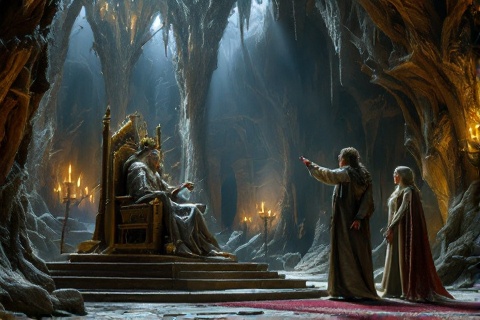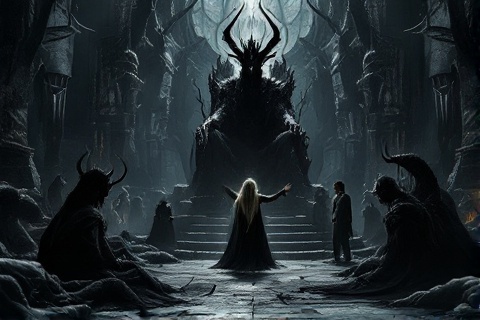
The Tale of Beren and Lúthien
A Love That Defied Fate
Origins of the Tale
The tale of Beren and Lúthien
stands as one of J.R.R. Tolkien's most personal works, deeply inspired by his
relationship with his beloved wife Edith. Tolkien was particularly moved by a
moment when Edith danced for him in a flowering hemlock grove, which directly
inspired the pivotal scene of Lúthien dancing among the flowers. After Edith's
death, Tolkien had the name 'Lúthien' inscribed on her tombstone, while his own
bears the name 'Beren.'
The story first took shape in the 1910s during Tolkien's recovery from trench
fever after the Battle of the Somme. Originally titled 'The Tale of Tinúviel,'
it appeared in The Book of Lost Tales before finding
its definitive form in The Silmarillion. This legendary
romance would become one of the foundational stories of Tolkien's entire
mythology, influencing the development of his broader legendarium.
The narrative draws deeply from medieval romance traditions, particularly the
quest motif where a suitor must prove his worth through an impossible task.
Elements from Finnish mythology, specifically the Kalevala's tale of the Sampo,
influenced the quest for the Silmaril. The story's themes
of mortality, sacrifice, and the union between different races would become
recurring elements throughout Tolkien's works.
The Meeting in Doriath

In the First Age of Middle-earth, Beren
son of Barahir fled south after Morgoth's forces overran
his homeland of Dorthonion. After enduring great hardships and becoming a
hardened survivor in the wilderness, he crossed the Grinding Ice of Helcaraxë
and entered the enchanted realm of Doriath, protected by Queen
Melian's impenetrable girdle of power.
Within the protected forests of Doriath, Lúthien, daughter of King Thingol and
the Maia Melian, often danced beneath the moonlight in a glade
filled with hemlock flowers. Her beauty was beyond any in Middle-earth, with
dark hair, grey eyes, and a face of surpassing loveliness. She wore a cloak
embroidered with blue flowers, and her movements were said to enchant all who
witnessed them.
Upon seeing Lúthien dance, Beren was instantly enchanted by her beauty and
grace. In that moment, he gave her the name Tinúviel, which means nightingale in
the ancient tongue, for her voice was as beautiful as that of the evening birds.
This name would become legendary in songs and tales throughout the ages of
Middle-earth.
The Challenge of Thingol

When Beren finally approached the throne of Menegroth to declare his love for
Lúthien, King Thingol was filled with scorn and anger. Despite Lúthien's obvious
affection for Beren, Thingol, who held all mortals in low regard, refused to
consider allowing his daughter, the most beautiful of all the Children of
Ilúvatar, to marry a mortal man.
In his pride and cunning, Thingol devised what he believed to be an impossible
task. He declared that Beren could only claim Lúthien's hand if he brought back
one of the Silmarils, the holy jewels that the Dark Lord Morgoth had stolen from
the Noldor. These gems were set in Morgoth's iron crown and
guarded in the impenetrable fortress of Angband in the far
north.
Beren, showing the courage and determination that would make him legendary,
accepted the challenge without hesitation. He famously responded to Thingol's
demand by declaring that he would return with a Silmaril in his hand, a vow that
would set in motion one of the greatest quests of the First Age.
The Quest Begins
Beren's quest led him first to the hidden realm of
Nargothrond, where he sought the aid of King Finrod
Felagund. Finrod had sworn an oath to Beren's
father Barahir, who had once saved his life, and thus felt bound by honor to
assist in this seemingly impossible quest. Despite opposition from his own
people, particularly the sons of Fëanor, Finrod
chose to honor his oath.
Through the power of songs of magic, Finrod disguised Beren, himself, and ten
loyal warriors as a band of orcs. Their enchanted appearances were
complete, from their twisted forms to their crude armor and weapons, allowing
them to travel north through enemy territory without immediate detection.
The group's journey brought them to the isle of Tol-in-Gaurhoth, formerly Minas
Tirith, which had been captured by Sauron, Morgoth's most
powerful servant. Here, they encountered a force that would test their disguises
and their courage, as Sauron was a master of deception and could sense the
presence of intruders in his domain.
Lúthien's Escape

When news of Beren's capture reached Doriath, Lúthien felt his torment through
their deep spiritual connection. Despite the apparent hopelessness of his
situation, she resolved to aid him, knowing that she alone might have the power
to challenge Sauron through her inherited magical abilities as daughter of
Melian the Maia.
King Thingol, learning of his daughter's intention to follow Beren, had her
confined in a house built high in the branches of Hírilorn, the greatest of all
the trees in Doriath. Guards were posted beneath, and all paths of escape seemed
blocked to prevent her from embarking on what seemed a suicidal rescue mission.
Through her magical arts and determination, Lúthien devised an ingenious escape
plan. She used her powers to grow her hair to an extraordinary length, and from
it wove an enchanted cloak imbued with a spell of sleep and shadows. This
magical garment allowed her to slip past her guards and escape her wooden
prison, demonstrating that her powers were greater than her father had
suspected.
The Duel with Sauron
Upon reaching Tol-in-Gaurhoth, Lúthien found an unexpected ally in Huan, the
great wolfhound of Valinor who had abandoned his master
Celegorm to aid her cause. Together, they confronted Sauron at his fortress,
challenging his dominion over the isle that had once belonged to Finrod
Felagund.
In the ensuing battle, Sauron demonstrated his shapeshifting abilities,
transforming into various terrifying forms including a giant wolf. However, it
had been prophesied that Huan could only be killed by the greatest wolf ever to
walk Middle-earth, and Sauron was not yet that creature. After an intense
struggle, Huan proved victorious, forcing Sauron to flee in the form of a
vampire bat.
Following their victory, Lúthien and Huan freed the prisoners from Sauron's
dungeons, finding Beren alive but grieving. They discovered that Finrod Felagund
had perished in combat with a werewolf while protecting Beren, fulfilling his
oath to Barahir at the cost of his own life. This sacrifice would be long
remembered in the songs and tales of the First Age.
Journey to Angband

After their escape from Tol-in-Gaurhoth, Beren attempted to continue his quest
alone, hoping to protect Lúthien from the terrible dangers that lay ahead.
However, Lúthien's love and determination proved stronger than his protests. She
refused to be left behind, declaring that their fates were now intertwined and
their quest must be completed together.
The pair devised a cunning plan using the remains of their defeated enemies.
They took the pelt of Draugluin, the great werewolf, and the hide of
Thuringwethil, Sauron's vampire messenger, using them as disguises. Through
Lúthien's magic, they transformed themselves into these fearsome creatures,
making their approach to Angband more feasible.
Together, they made the perilous journey across Anfauglith,
the gasping dust plain before Morgoth's fortress of Angband. Their disguises
proved effective, allowing them to pass through the gates of the iron fortress
where no enemy had yet managed to enter freely.
Before Morgoth's Throne

In Morgoth's great hall, Lúthien revealed herself, appearing before his throne
in her full beauty. She offered to dance for the Dark Lord and his court, and
began a performance of such mesmerizing power that even Morgoth was entranced.
Through her divine heritage and magical abilities, she wove a spell of deep
sleep that gradually overcame all present, including Morgoth himself.
With the dark court unconscious, Beren seized the opportunity to approach
Morgoth's iron throne. Using the knife Angrist, forged by
the legendary smith Telchar of Nogrod, he managed to cut one of the Silmarils
from Morgoth's crown. The holy jewel did not burn his hand, proving his pure
heart and right to the quest.
During their escape from Angband, they encountered the great wolf Carcharoth,
bred by Morgoth himself as the mightiest of all wolves. When Beren attempted to
ward off the wolf by holding up the Silmaril, Carcharoth bit off his hand
entire, swallowing it along with the holy jewel. The burning power of the
Silmaril drove the wolf mad with pain and rage.
The Wolf Hunt
The maddened Carcharoth, driven by the burning Silmaril within him, broke
through Melian's Girdle and rampaged through the forests of Doriath. His passage
brought terror and destruction to the protected realm, slaying many before the
great hunt could be organized to stop him.
King Thingol assembled the greatest hunters in his realm, including Beren, Huan,
and Mablung of the Heavy Hand, to track down and destroy the wolf. The hunting
party followed Carcharoth's trail of destruction through the forests of Region
and Neldoreth.
In the final confrontation, Huan proved true to his destiny, engaging in a
fierce battle with Carcharoth. The two mighty beings fought to the death, with
Huan fulfilling the prophecy that he would fall to the greatest wolf ever to
walk Middle-earth. Before the end, Beren attempted to aid his friend and was
mortally wounded by the wolf, though Carcharoth was finally slain and the
Silmaril recovered from his belly.
Love Transcending Death

As Beren lay dying from his wounds, Lúthien's spirit began to fade from grief.
She used her healing powers to save him, but the effort drained her own life
force. When both their spirits departed to the Halls of Mandos, Lúthien sang a
song of such beauty and sorrow before Mandos that it moved even the implacable
Vala to pity.
The Valar presented Lúthien with a choice: she could either dwell
in Valinor forever in bliss, or return to Middle-earth with Beren as a mortal.
She chose mortality, becoming the first and only Elf to permanently surrender
her immortality for love. Together, they returned briefly to Middle-earth as
mortals.
Their sacrifice and the power of their love moved the Valar deeply, influencing
their perspective on the relationship between Elves and
Men. This decision would have far-reaching consequences, setting a
precedent for future unions between the two races and affecting the fate of all
Middle-earth.
Legacy and Influence
The legacy of Beren and Lúthien continued through their son Dior and subsequent
generations, creating a lineage that would profoundly shape the history of
Middle-earth. Through their descendants, including Elrond Half-elven and
eventually Aragorn, their noble blood and the
memory of their great deed would influence events thousands of years later
during the War of the Ring.
The Lay of Leithian, which recounts their tale, became the greatest and most
revered of all songs in Middle-earth. Elven minstrels would sing of their deeds
in both joy and sorrow, preserving the memory of their love and sacrifice
through the ages. Their story was considered the most beautiful and moving of
all the tales from the First Age.
The union of Beren and Lúthien represented the first and most important marriage
between the kindreds of Elves and Men. Their story established the possibility
of love transcending the boundaries between the races, paving the way for later
unions such as those of Tuor and Idril, and Aragorn and Arwen. Their tale
remained a symbol of hope and the power of love to overcome all obstacles, even
death itself.
